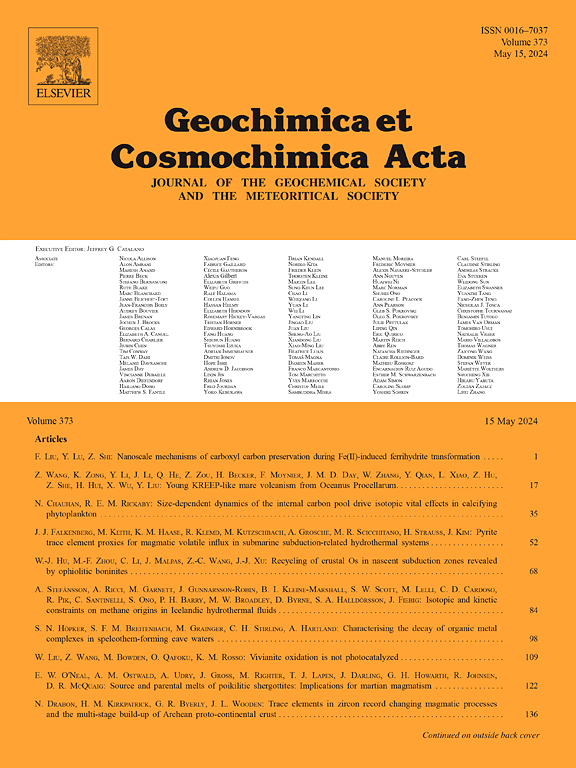Light iron isotopes in high-silica granites record fluid evolution in magmatic-hydrothermal systems
IF 4.5
1区 地球科学
Q1 GEOCHEMISTRY & GEOPHYSICS
引用次数: 0
Abstract
High-silica (SiO2 > 70 wt%) granites in continental collisional zones are crucial for understanding formation and evolution of the upper continental crust. Fluids released from felsic magmas can help drive the transition from magmatic to magmatic-hydrothermal systems in shallow magma chambers. However, the influence of these fluids on compositional variations and Fe isotope fractionation during the later stages of evolution of felsic magmas are unclear. In this contribution, we report stable Fe–Mg isotope compositions for the Paleocene Zhengga leucogranite pluton, part of the Gangdese batholith in southern Tibet. The pluton consists of both biotite granite and garnet-bearing two-mica granite, the latter of which contains zoned plagioclase and patchy K-feldspar that show fluid-mediated partial replacement textures, recording complicated magmatic and hydrothermal processes. Compared to high-silica granites worldwide (δ57Fe = +0.10 ‰ to +0.74 ‰), all rocks from the Zhengga leucogranite pluton have light and variable δ57Fe values (+0.03 ‰ to +0.28 ‰ relative to IRMM-014), which display wave-shaped variations with progressive magmatic differentiation. However, their δ26Mg values (relative to DSM-3) decrease from −0.12 ‰ to −0.72 ‰ with increasing SiO2. The variable Fe and Mg isotope signatures of the Zhengga pluton can be best explained by a three-stage process, comprising initial fractional crystallization of biotite and magnetite, followed by deuteric fluid exsolution with decreasing temperatures and pressures, and final interaction between trapped fluids and residual melts in the highly crystalline magma mush. In combination with previously published Sr–Nd–Mo isotopes on the same samples, our new results suggest that fluid exsolution is required to elevate the δ57Fe of the felsic melts by up to 0.15 permil, but subsequent fluid-melt reaction reduces the Fe isotopes and leads to similar light-Fe isotope compositions of final residual melts to their primary magma. Therefore, the high-silica granites can be enriched in light Fe isotopes due to the effects of magmatic fluids, which make a significant contribution to the formation and evolution of upper continental crust.
高硅花岗岩的轻铁同位素记录了岩浆-热液系统的流体演化
高硅(SiO2 >;70% (wt%)的大陆碰撞带花岗岩对于理解上大陆地壳的形成和演化至关重要。长英质岩浆释放的流体有助于推动浅层岩浆房从岩浆系统向岩浆热液系统的过渡。然而,这些流体在长英质岩浆演化后期对其成分变化和铁同位素分馏的影响尚不清楚。本文报道了藏南冈底斯基古新世正嘎浅花岗岩体的稳定Fe-Mg同位素组成。岩体由黑云母花岗岩和含石榴石的二云母花岗岩组成,二云母花岗岩含分带斜长石和斑状钾长石,呈流体介质部分置换结构,记录了复杂的岩浆和热液作用。与世界范围内的高硅花岗岩(δ57Fe = +0.10‰~ +0.74‰)相比,正伽浅花岗岩体δ57Fe值均较轻且变化较大(相对于IRMM-014 δ57Fe值为+0.03‰~ +0.28‰),δ57Fe值随岩浆分异呈波浪状变化。δ26Mg值(相对于DSM-3)随SiO2的增加而从- 0.12‰降至- 0.72‰。正伽岩体的铁、镁同位素变化特征可以用三个阶段来解释,即黑云母和磁铁矿的初始分离结晶,随后是氘流体在温度和压力降低的条件下析出,最后是高结晶岩浆浆中被困流体和残余熔体的相互作用。结合前人发表的相同样品的Sr-Nd-Mo同位素,我们的新结果表明,流体溶蚀使长英质熔体的δ57Fe升高了0.15 permil,但随后的流体-熔体反应降低了Fe同位素,导致最终残余熔体的轻铁同位素组成与其原始岩浆相似。因此,高硅花岗岩在岩浆流体作用下可富集轻铁同位素,对上大陆地壳的形成演化有重要贡献。
本文章由计算机程序翻译,如有差异,请以英文原文为准。
求助全文
约1分钟内获得全文
求助全文
来源期刊

Geochimica et Cosmochimica Acta
地学-地球化学与地球物理
CiteScore
9.60
自引率
14.00%
发文量
437
审稿时长
6 months
期刊介绍:
Geochimica et Cosmochimica Acta publishes research papers in a wide range of subjects in terrestrial geochemistry, meteoritics, and planetary geochemistry. The scope of the journal includes:
1). Physical chemistry of gases, aqueous solutions, glasses, and crystalline solids
2). Igneous and metamorphic petrology
3). Chemical processes in the atmosphere, hydrosphere, biosphere, and lithosphere of the Earth
4). Organic geochemistry
5). Isotope geochemistry
6). Meteoritics and meteorite impacts
7). Lunar science; and
8). Planetary geochemistry.
 求助内容:
求助内容: 应助结果提醒方式:
应助结果提醒方式:


